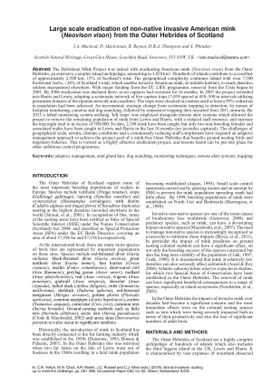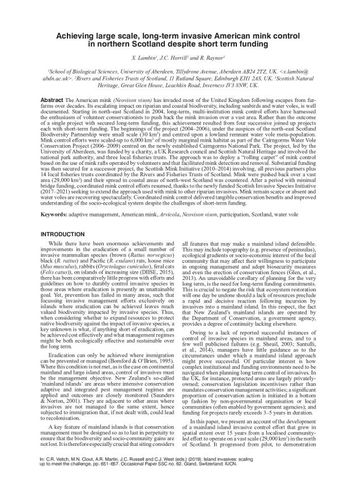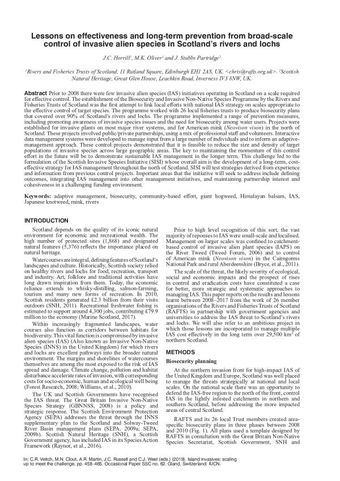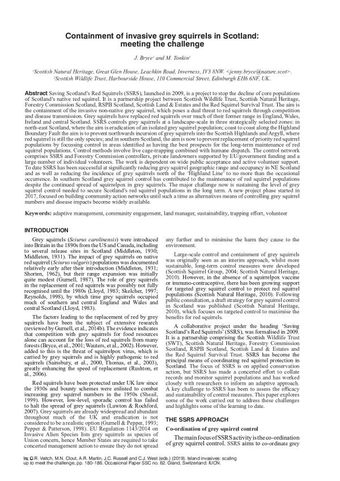Large scale eradication of non-native invasive American mink (Neovison vison) from Outer Hebrides of Scotland
- Description:
- The Hebridean Mink Project was tasked with eradicating American mink (Neovison vison) from the Outer Hebrides, an extensive, complex island archipelago, amounting to 3,050 km2. Hundreds of islands contribute to a coastline of approximately 2,500 km, 15% of Scotlands total. The geographical complexity continues inland with over 7,500 freshwater lochs, ~24% of Scotlands total, which enables invasive American mink, in suitable habitats, to reach densities seldom encountered elsewhere. With major funding from the EU LIFE programme, removal from the Uists began in 2001. By 2006 eradication was declared there, as no captures had occurred for 16 months. In 2007 the project extended into Harris and Lewis, adopting a systematic network of live capture traps (7,039 spaced at 450500 m intervals utilising prominent features of the riparian network and coastline). The traps were checked in rotation until at least a 95% reduction in population had been achieved. An incremental, strategic change from systematic trapping to detection; by means of footprint monitoring, cameras and dog searching, followed by responsive trapping then occurred from 2011 onwards. By 2013 a lethal monitoring system utilising kill traps was employed alongside remote alert systems which allowed the project to remove the remaining population of mink from Lewis and Harris, with a reduced sta? resource, and increase the trap night total to in excess of 500,000. To date, 2,198 mink have been caught, but only two non-breeding females and associated males have been caught in Lewis and Harris in the last 18 months (no juveniles captured). The challenges of geographical scale, terrain, climatic conditions and a continuously reducing sta? complement have required an adaptive management approach to achieve the project goal of a mink-free Outer Hebrides that bene?ts ground nesting birds and migratory ?sheries. This is viewed as a highly e?ective eradication project, and lessons learnt can be put into place for other ambitious control programmes.
- Display date:
- 2019
- Location:
- Pacific Region
- Collections:
- Secretariat of the Pacific Regional Environment Programme (SPREP)
- Publisher:
- International Union for Nature Conservation (IUCN)
- Content partner:
- Secretariat of the Pacific Regional Environment Programme (SPREP)
- Availability:
- Not specified
-
Copyright status: All rights reservedFind out more about what you are able to do with this itemThis item is all rights reserved, with means you'll have to get permission from Secretariat of the Pacific Regional Environment Programme (SPREP) before using it. For more information, please see our use and reuse page.What can I do with this item?Non-infringing useNZ copyright law does not prevent every use of a copyright work, and this item may be hosted by an international institute or organisation. You should consider what you can and cannot do with a copyright work.No sharingYou may not copy and/or share this item with others without further permission. This includes posting it on your blog, using it in a presentation, or any other public use.No modifyingYou are not allowed to adapt or remix this item into any other works.No commercial useYou may not use this item commercially.
Related items
Welcome and warm Pasifik greetings
The information on this site has been gathered from our content partners.
The names, terms, and labels that we present on the site may contain images or voices of deceased persons and may also reflect the bias, norms, and perspective of the period of time in which they were created. We accept that these may not be appropriate today.
If you have any concerns or questions about an item, please contact us.



